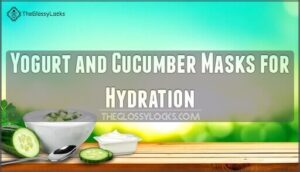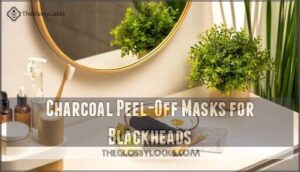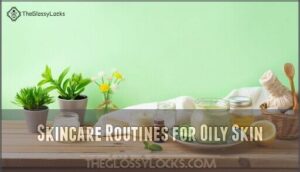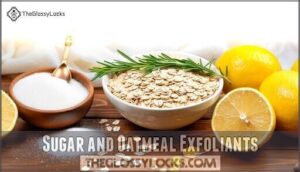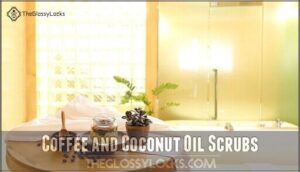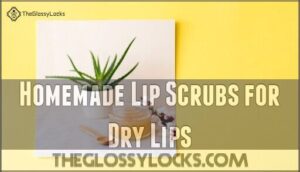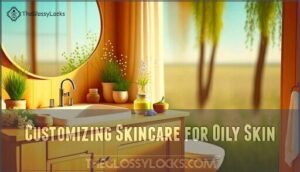This site is supported by our readers. We may earn a commission, at no cost to you, if you purchase through links.

Jojoba oil actually tricks your sebaceous glands into producing less oil by mimicking your skin’s natural sebum.
Bentonite clay works like a magnet, drawing out impurities while keeping your skin’s pH balanced.
Honey brings antibacterial power that fights breakouts while sealing in moisture without clogging pores.
Aloe vera hydrates without adding grease, and studies show noncomedogenic oils can reduce sebum production by up to 30%.
DIY natural skincare for oily skin isn’t just budget-friendly—it’s gentler than harsh commercial products that often backfire by triggering more oil production.
The secret lies in understanding which natural ingredients actually work with your skin’s chemistry rather than against it, using ingredients like jojoba oil, aloe vera, and bentonite clay to achieve a balanced skin care routine that is also noncomedogenic.
Table Of Contents
- Key Takeaways
- Natural Skincare Basics
- Homemade Face Masks
- Skincare Routines for Oily Skin
- DIY Exfoliants and Scrubs
- Customizing Skincare for Oily Skin
- Frequently Asked Questions (FAQs)
- How do you make homemade skin care for oily skin?
- How can I clear my skin in 7 days for oily skin?
- How do I stop my face from being so oily naturally?
- How do you make homemade skincare for oily skin?
- What is the best natural remedy for oily skin?
- What skincare routine should I have if I have oily skin?
- Which is the best homemade face pack for oily skin?
- Can homemade skincare cause allergic reactions?
- How long do DIY skincare products last?
- What oils should oily skin avoid completely?
- Conclusion
Key Takeaways
- You’ll balance oil production naturally by using jojoba oil, which tricks your sebaceous glands into producing 30% less sebum instead of stripping your skin with harsh chemicals.
- You can create effective treatments from kitchen staples like honey (antibacterial properties), bentonite clay (absorbs excess oil), and aloe vera (hydrates without clogging pores).
- You’ll save money while avoiding the rebound effect that commercial products often cause—when you strip natural oils, your skin overcompensates by producing even more oil.
- You need consistency over perfection in your routine: gentle cleansing twice daily, clay masks 2-3 times weekly, and oil-free moisturizing to prevent your skin from overproducing sebum.
Natural Skincare Basics
Creating your own skincare products lets you control exactly what goes on your face while saving money compared to expensive store-bought treatments.
You’ll need just a few key ingredients like honey, clay, and oils to tackle oily skin’s unique challenges without harsh chemicals that can actually make oil production worse, using oils in a way that benefits your skin.
Essential Ingredients for Oily Skin
Transform your oily skin care routine with these powerhouse natural ingredients.
Transform your skincare game with nature’s most powerful ingredients
You’ll discover noncomedogenic oils like jojoba oil that actually reduce sebum production by up to 30%, plus soothing aloe vera and oil-absorbing bentonite clay.
Understanding the benefits of jojoba oil products can help you make informed decisions about your skincare routine.
Key DIY natural skincare essentials:
- Jojoba oil – mimics your skin’s sebum to balance oil production
- Bentonite clay – draws out impurities while maintaining pH balance
- Aloe vera – hydrates without clogging pores and fights inflammation
Benefits of Natural Skincare
Natural skincare offers you freedom from harsh chemicals while supporting your skin’s natural balance.
Green beauty ingredients like honey, aloe vera, and clay work gently with your sebaceous glands rather than against them.
Eco friendly DIY natural skincare saves money while delivering proven results.
Your oily skin care routine becomes more effective when natural remedies nourish without stripping essential oils.
Organic products reduce irritation and breakouts naturally, and using natural skincare can have a significant impact on your skin’s health.
DIY Skincare Tools and Equipment
Ready to create your homemade skincare masterpieces? You’ll need the right tools to whip up effective diy skincare recipes.
Think of these essentials as your skincare laboratory starter kit:
- Glass jars for storing your diy natural skincare creations
- Spray bottles and double boilers for mixing homemade skincare treatments
- Konjac sponges for gentle exfoliation with your diy face mask recipes
These simple tools transform your kitchen into a skincare diy paradise!
To achieve desirable results, understanding natural skincare benefits is vital for creating effective recipes.
Homemade Face Masks
Face masks are your skin’s best friend when you’re dealing with excess oil and stubborn breakouts.
These DIY treatments work by targeting specific concerns like clogged pores, acne-causing bacteria, and inflammation while using ingredients you likely already have in your kitchen, which can help with inflammation.
Clay Masks for Oil Control
Clay masks work like oil-absorbing magnets for your skin.
Bentonite clay reduces surface sebum by 40% after one session, while gentler kaolin clay suits sensitive types.
Multani Mitti and rose clay offer powerful oil control with minerals.
Apply twice weekly for 10-15 minutes, then rinse with lukewarm water for best results.
Using the right oil control methods can substantially improve the effectiveness of clay masks for oily skin.
Honey and Lemon Masks for Acne
When acne’s got you down, honey and lemon juice create a powerful DIY face mask that fights breakouts naturally.
Honey’s antibacterial properties reduce acne-causing bacteria while sealing in moisture, and lemon juice provides gentle skin purification through natural acids.
Mix equal parts for this simple natural remedy that targets oily skin without harsh chemicals—your go-to acne treatment using natural remedies.
Yogurt and Cucumber Masks for Hydration
While honey and lemon tackle acne head-on, sometimes your skin craves pure refreshment. Yogurt cucumber masks offer the perfect hydrating solution for oily skin that’s tired of harsh treatments.
Here’s your simple recipe:
- Mix 2 tablespoons plain yogurt with ½ cucumber, blended
- Apply evenly, avoiding eye area
- Leave for 15-20 minutes until slightly dry
- Rinse with cool water, pat dry gently
This powerhouse combo delivers cucumber benefits through natural cooling properties while yogurt’s lactic acid gently exfoliates. The result? Balanced hydration that won’t clog pores. Using a yogurt face mask can provide additional benefits to enhance your skincare routine.
Charcoal Peel-Off Masks for Blackheads
Why struggle with stubborn blackheads when activated charcoal can pull them right out?
This powerhouse ingredient acts like a magnet, drawing impurities from deep within your pores.
Mix activated charcoal powder with egg white and honey for a DIY peel-off mask that’ll transform your oily skin.
The charcoal benefits include deep pore cleansing and blackhead removal that beats expensive store-bought options.
Skincare Routines for Oily Skin
Creating a consistent skincare routine is your secret weapon against oily skin’s daily challenges.
You’ll need both morning and evening rituals that work with your skin’s natural rhythms, plus smart exfoliation and moisturizing techniques that won’t trigger more oil production, utilizing smart methods to achieve the best results.
Morning and Night Skincare Routines
Your daily skincare routine becomes your skin’s best ally when you nail the timing and sequence.
Your skin deserves consistency—timing and sequence unlock the magic.
After enjoying those nourishing face masks, it’s time to establish consistent morning and evening rituals that’ll keep your oily skin balanced and happy.
Here’s your game-changing routine breakdown:
- Morning Cleansing Tips: Start with a gentle, salicylic acid cleanser to remove overnight oil buildup without stripping your skin’s natural barrier
- Strategic Toner Applications: Follow with an alcohol-free toner containing witch hazel to minimize pores and prep skin for moisturizer absorption
- Perfect Moisturizer Timing: Apply oil-free moisturizer while skin’s still damp to lock in hydration and prevent sebaceous glands from overproducing oil
Your nighttime routine mirrors the morning but adds targeted treatments.
Consider your evening ritual as skin repair time—this is when your DIY natural skincare ingredients work hardest.
Focus on gentle Eye Care around delicate areas, and remember that consistent Skin Balancing takes patience.
These Oily Skin Tips aren’t just theory; they’re your roadmap to clearer, healthier skin through proper Oily Skin Management using Natural Ingredients.
Exfoliating Techniques for Oily Skin
Exfoliating oily skin requires the right balance—too little won’t remove dead cells, too much triggers more oil production.
Use natural exfoliants like oatmeal or sugar 2-3 times weekly with gentle circular motions.
Chemical peels with salicylic acid penetrate deeper than physical exfoliation alone.
Enzyme exfoliants from honey offer antimicrobial benefits while dissolving buildup naturally.
Effective skin care routines often involve understanding oily skin types to customize exfoliation approaches.
Moisturizing Tips for Oily Skin
Three simple rules can transform your oily skin game.
Choose gel-based or water-based moisturizers with hyaluronic acid for lightweight skin hydration without grease.
Apply DIY moisturizers like aloe vera mixed with jojoba oil immediately after cleansing—your skin absorbs better when damp.
Don’t skip this step; dehydrated skin actually triggers more oil production, creating a vicious cycle you’ll want to break.
Sunscreen and UV Protection
Beyond your DIY skincare routine, UV protection remains your skin’s best defense against premature aging and skin cancer.
Choose broad spectrum sunscreen with SPF 30 or higher, applying generously 30 minutes before sun exposure.
Mineral sunscreens containing zinc oxide work wonderfully for oily skin, providing effective UV protection without clogging pores or adding unwanted shine to your complexion, which is a key part of your skincare routine.
DIY Exfoliants and Scrubs
Exfoliating your oily skin doesn’t require expensive store-bought scrubs that might contain harsh chemicals your skin doesn’t need.
You can create effective, gentle exfoliants right in your kitchen using simple ingredients like sugar, oatmeal, coffee grounds, and even tomatoes that’ll help unclog pores and remove dead skin cells without over-drying your face, which is a gentle way to care for your skin.
Sugar and Oatmeal Exfoliants
Sugar scrubs and oatmeal masks work like gentle warriors for oily skin.
These DIY natural skincare champions deliver powerful exfoliation benefits while keeping your complexion balanced.
Here’s how these natural peels transform your routine:
- Sugar dissolves gradually – providing gentler exfoliation than harsh salt scrubs
- Oatmeal contains natural saponins – cleansing pores without stripping essential oils
- Both ingredients act as humectants – drawing moisture into freshly exfoliated skin
- Customizable textures – adjust grain size for your skin’s sensitivity level
These gentle cleansers remove dead cells while supporting your skin’s natural barrier.
Using a diy lemon sugar body scrub can also enhance exfoliation and skin hydration.
Coffee and Coconut Oil Scrubs
Transformation happens when coffee grounds meet coconut oil in perfect harmony.
This dynamic duo creates an invigorating scrub that’ll wake up your skin faster than your morning espresso.
The caffeine stimulates circulation while coconut oil provides gentle moisturization without clogging pores.
Using a coffee scrub product with coffee skin benefits can enhance the overall effectiveness of your DIY skincare routine.
| Ingredient | Benefits |
|---|---|
| Coffee grounds | Stimulates circulation, reduces inflammation |
| Coconut oil | Moisturizes, antimicrobial properties |
| Brown sugar (optional) | Adds gentle abrasive texture |
| Vitamin E oil (2-3 drops) | Antioxidant protection, healing |
Tomato and Sugar Exfoliants for Oily Skin
Creating effective tomato and sugar exfoliants harnesses tomato’s natural salicylic acid and sugar’s physical exfoliation for powerful oil control.
You’ll blend one fresh tomato with two tablespoons sugar to create this potent homemade exfoliant.
The acids in tomatoes chemically unclog pores while sugar physically removes dead skin cells.
This DIY natural skincare treatment targets oily skin specifically, offering natural ingredients that provide dual-action skin benefits without harsh chemicals, utilizing the natural properties of tomatoes and sugar for oil control.
Homemade Lip Scrubs for Dry Lips
Chapped lips need more than moisturizer—they need gentle exfoliation first.
Your coconut oil lip scrub combines one tablespoon coconut oil with two tablespoons sugar for effective lip exfoliants.
This homemade sugar scrub removes dead skin while natural moisturizers penetrate deeper.
Massage gently, rinse, then follow with DIY natural skincare like homemade natural eye cream for complete care, using your coconut oil lip scrub as part of a broader natural skincare routine.
Customizing Skincare for Oily Skin
Oily skin isn’t one-size-fits-all, and what works for your friend’s T-zone might leave your skin feeling tight or even oilier.
Once you understand your specific skin concerns and sebum patterns, you can create a personalized routine that targets your unique needs without the guesswork.
Identifying Skin Types and Concerns
Before you create your skincare routine, you need to figure out what type of skin you’re working with.
Understanding your skin’s behavior helps you choose the right oily skin treatments and oil control tips.
Try the blotting test – press tissue paper on your T-zone after two hours.
If it shows grease, you’ve got oily skin that needs targeted pore minimization and acne prevention strategies.
Tailoring Skincare Routines for Individual Needs
Once you’ve mastered skin typing and needs assessment, it’s time to build your personalized diy natural skincare arsenal.
Your oily skin solutions aren’t one-size-fits-all—what works for your T-zone might overwhelm your cheeks.
Practice skin mapping to identify different areas’ needs, then create a product rotation system.
Adjust your skincare routine seasonally, using heavier natural ingredients during winter and lighter oil control tips in summer to keep your skin balanced year-round.
Using Essential Oils for Skincare
Essential oils can supercharge your natural skincare routine when you blend them wisely.
Tea tree oil tackles acne-causing bacteria, while geranium balances oily skin types.
Always dilute to 1-2% with jojoba or grapeseed carrier oils – your skin will thank you!
These aromatherapy powerhouses offer targeted natural remedies for specific skincare concerns.
Troubleshooting Common Skincare Issues
When your DIY skincare routine hits bumps, don’t panic! If you’re experiencing increased breakouts after starting natural treatments, your skin might be purging—this typically resolves within 2-4 weeks.
For persistent skin irritation, reduce application frequency or dilute ingredients. Over-cleansing can trigger excess oil production, so stick to twice daily.
If pore minimization isn’t working, make sure you’re consistently using clay masks and gentle exfoliants for proper oil control and breakout prevention.
To achieve effective results, understanding the best skin care routine is vital for managing oily skin effectively.
Frequently Asked Questions (FAQs)
How do you make homemade skin care for oily skin?
Mix honey with lemon, blend oatmeal with yogurt, or create clay masks with bentonite.
You’ll balance oil production, unclog pores, and soothe inflammation using kitchen staples that work better than expensive store-bought treatments, which helps to balance oil production.
How can I clear my skin in 7 days for oily skin?
Start with gentle cleansing twice daily using salicylic acid or benzoyl peroxide.
Apply clay masks twice weekly, exfoliate gently, and use oil-free moisturizer.
Consistency beats perfection—your skin needs time to adjust and heal properly.
How do I stop my face from being so oily naturally?
Your sebaceous glands might be working overtime, but don’t panic.
Use jojoba oil to trick them into producing 30% less sebum.
Apply honey-lemon masks twice weekly, and moisturize religiously—dehydrated skin overcompensates with excess oil production.
How do you make homemade skincare for oily skin?
You’ll want to harness the power of natural ingredients like honey, aloe vera, and oatmeal.
Blend honey with lemon for oil control, or create clay masks using bentonite clay to absorb excess sebum effectively, utilizing natural ingredients.
What is the best natural remedy for oily skin?
Ironically, fighting oily skin with more oil works best. Jojoba oil tricks your sebaceous glands into producing 30% less sebum, while honey’s antibacterial properties prevent breakouts and maintain moisture balance naturally.
What skincare routine should I have if I have oily skin?
Cleanse twice daily with gentle, salicylic acid-based cleanser.
Follow with alcohol-free toner containing witch hazel. Exfoliate 2-3 times weekly using chemical exfoliants.
Apply oil-free moisturizer with niacinamide. You’ll tame that shine!
Which is the best homemade face pack for oily skin?
Think of your face as a sponge that’s absorbed too much water—it needs gentle wringing out.
The honey-lemon combo’s your MVP here.
Mix equal parts raw honey and fresh lemon juice, apply for fifteen minutes, then rinse.
Honey’s antibacterial properties tackle breakouts while lemon’s natural acids balance oil production without overdrying.
Can homemade skincare cause allergic reactions?
Yes, homemade skincare can trigger allergic reactions.
Natural doesn’t mean hypoallergenic—ingredients like essential oils, citrus, or honey can cause contact dermatitis.
Always patch-test new recipes on your inner wrist first.
How long do DIY skincare products last?
Your freshly made skincare goodies won’t outlast a tub of store-bought cream, but they’ll still treat your skin beautifully for weeks when stored properly in the fridge.
What oils should oily skin avoid completely?
You’ll want to skip heavy, pore-clogging oils like coconut, palm, and wheat germ oil. These comedogenic culprits can trigger breakouts and worsen shine on your already oily complexion.
Conclusion
Creating DIY natural skincare for oily skin is like tending a garden—you need the right ingredients, patience, and understanding of what your skin craves.
Your sebaceous glands don’t need harsh chemicals that strip away natural oils, triggering overproduction.
Instead, they respond beautifully to gentle, science-backed ingredients like jojoba oil and bentonite clay.
These kitchen staples work with your skin’s natural chemistry, not against it.
Start simple, stay consistent, and watch your complexion transform naturally.
- https://schoolofba.com/8-natural-remedies-for-oily-skin/
- https://www.revivalabs.com/is-oil-free-skincare-good-for-oily-skin/
- https://www.minaturewellness.com/blogs/news/the-ultimate-guide-to-herbal-skincare-for-oily-skin
- https://www.youtube.com/watch?v=oHdJxZ0wuQQ
- https://zoskinhealth.com/us/blog/skincare-protocols/best-ingredients-for-oily-skin.html



